Seed and Cutting Exchange at Kirk Park
Date: September 20, 11:00 am - 1:00 pm
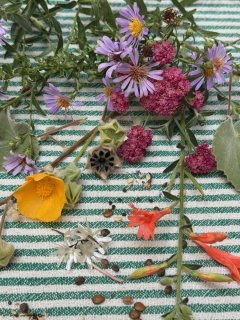
Location: Picnic Area at Kirk Park
We have an exciting new venue for the September Seed and Cutting Exchange: The Kirk Park Native Plant Pollinator Garden in San Jose. We have reserved the park’s picnic area for the event.
Come explore the 14,000 square foot native plant garden at Kirk Park. There will be garden docents onsite, and a nearby picnic table area with free seeds, and cuttings. Many of the cuttings available can be viewed in the garden itself!
We will have live, interactive cutting demonstrations, so you can learn to start your very own cuttings to take home. You may also bring your own containers for transporting cuttings. Free seed packets will include both wildflower annuals and perennials. Some of the individual annual wildflower packets include Lupines, Clarkias, Tidy Tips and more! For unpackaged, lose seeds, small coin envelopes will be provided.
It is not necessary to bring anything if you do not have native material to share. However, if you have native plant material from your garden that you would like to share, please bring it along. Be sure to label your contributions for easy browsing – helpful growing tips and photos of the plants in bloom are appreciated. You may find it useful to use Calscape.org for this purpose; there is a link on the plant’s information page that allows you to create a printable sign for most native species and cultivars. If you bring cuttings, please ensure they remain cool and moist in a bucket of water.
Our Wildflower Ambassadors will also be distributing free seed packets and information.
Contact This email address is being protected from spambots. You need JavaScript enabled to view it. with any questions.
Street Parking: From Foxworthy Avenue, turn left on Briarwood Drive, and go about a block. The park is on your left. Park along Briarwood Drive.
Picture courtesy of Michelle Deandra
Native Plant ID (formerly Keying with Natives)

Native Plant ID (formerly Keying with Natives) is a Chapter group that works together to learn plant identification using botanical keys and other resources. Join us as we look at plant samples collected from local gardens and practice methods of identifying the native plants of our region. Bring in plant samples if you have some from property where you have permission to collect or just come and work with the materials provided. We will use a variety of plant books and online resources as we endeavor to improve our understanding of botanical terms used in plant identification. The chapter has 10x hand lenses and dissecting microscopes that we can use to look at small plant parts or bring your own lens. Also bring any of the following reference books that you have:
- The Jepson Manual, 2nd Edition, Willis Linn Jepson, available in hardcover or digital version
- Plants of the San Francisco Bay Region: Mendocino to Monterey, Third Edition, Linda H. Beidleman and Eugene N. Kozloff
- Pacific States Wildflowers, Theodare F. Niehaus and Charles L. Rippe
- A Sierra Nevada Flora, Norman F. Weeden
- Spring Wildflowers of the San Francisco Bay Region and Flora of the Mount Hamilton Range, Helen K. Sharsmith
- Wildflowers of the West, Mabel Crittenden and Dorothy Telfer
- Plant Identification Terminology, An Illustrated Glossary, by James G. Harris and Melinda Woolf Harris, 2nd Edition
Native Plant ID meets the fourth Tuesday of the month at the Peninsula Conservation Center, 3921 E Bayshore Rd, Palo Alto. Join other native plant enthusiasts in a fun and educational atmosphere, as we hone our skills at plant identification (aka “keying”). For details, contact Janet Hoffmann at This email address is being protected from spambots. You need JavaScript enabled to view it..
Additional Resources
Dee Himes (former CNPS SCV board member, Field Trip Chair, chapter Treasurer, “Weed Warrior” at Edgewood County Park and Preserve and Adjunct Instructor of horticulture at Foothill College, in their Environmental Horticulture and Design program, which she also graduated from with an A.S. in 2006) recorded two online classes that go over the basics of Plant Morphology and the basics of Plant Taxonomy. They cover the basic principles of morphology, which is the study of the form, external structure and development of plants; and the basic principles of taxonomy, which is to learn and look at different plant families. The classes are a good resource for learning the terminology of plant identification.
Additional online resources:
Seed Packet Information: Hills of California
Hills of California
We hope you enjoy your seeds from the CNPS SCV Wildflower Ambassadors program. This plant mix is designed to provide flowers over a period of three months in the spring and early summer in a sunny area.
Planting Instructions
Fall through winter is the ideal time to start growing California native wildflowers as these have adapted to capitalize on the fall and winter rains (October-February is best) and bloom in spring. They may be planted through April, but after that it is best to wait until at least September to plant them as they do not do well when planted in late spring or summer.
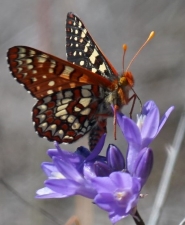 Choose A Site & Prepare Your Soil
Choose A Site & Prepare Your Soil
- Choose a spacious site in full sun.
- Prepare your soil (or several very large pots), by removing all existing growth and debris. If your soil is clay, break it up with some compost or cactus soil (sold at nurseries).
- Water thoroughly to help seeds settle into the soil. Continue to water a few times a week, unless it rains, so they don’t dry out after germinating. Seeds should sprout in one to three weeks.
- After you plant your seeds, let the area ‘go natural’ by leaving the leaf litter on the ground. While many butterflies go into chrysalis on stems or other hard surfaces like branches, many others go into chrysalis in the debris. If you rake or blow it, you could accidentally kill or throw them away.
Avoid using pesticides anywhere in your garden, it will kill the beneficial insects such as bees, butterflies, moths, and ladybugs that you are trying to attract. Try to ignore bugs, as they are part of the ecosystem (for instance, hummingbirds eat aphids). If you hose the plant or try to remove pests you may dislodge butterfly or ladybug eggs or kill tiny caterpillars. Avoid using herbicides as they also poison the ecosystem you are trying to nurture.
Plants In The Hills Of California Mix
- Farewell to Spring, Clarkia amoena (hosts White Lined Sphinx Moth, Clark’s Day Sphinx Moth)
- Mountain Garland, Clarkia unguiculata (hosts White Lined Sphinx Moth, Clark’s Day Sphinx Moth)
- Chinese Houses, Collinsia heterophylla (hosts Variable Checkerspot)
- California Poppy, Eschscholzia californica (useful to pollinators, hosts Acmon Blue, Dotted Blue, Mormon Metalmark, etc.)
- Globe Gilia, Gilia capitata (host to Fairy Longhorn Moth)
- Goldfields, Lasthenia glabrata (hosts Small Heliothodes Moth)
- Tidy Tips, Layia platyglossa (hosts Small Heliothodes Moth)
- Blue Flax, Linum lewisii (hosts Variegated Fritillary)
- Miniature Lupine, Lupinus bicolor (hosts Painted Lady, Acmon Blue, Gray Hairstreak)
- Sky Lupine, Lupinus nanus (hosts Orange Sulphur, Painted Lady, Acmon Blue, Gray Hairstreak)
- Arroyo Lupine, Lupinus succulentus (hosts West Coast Lady, Painted Lady, Acmon Blue, Gray Hairstreak)
- Five Spot, Nemophila maculate (hosts Funereal Duskywing)
- Baby Blue-Eyes, Nemophila menziesii (hosts Owlet Moth)
- Lacy Phacelia, Phacelia tanacetifolila – (hosts Bilobed Looper Moth, beloved by bees)
The list of moths and butterflies hosted by these plants is just a sample, these plants are a host to many more - a comprehensive list of butterflies each plant hosts, and details about the plants and butterflies, can be found at Calscape.org
*”Host” = key food source for the caterpillars of these particular butterflies, that co-evolved to specialize over thousands of years. Butterflies die out without these plants.
Seed Packet Information: California Shady Wildflower Mix
California Shady Wildflower Mix
We hope you enjoy your seeds from the CNPS SCV Wildflower Ambassadors program. This plant mix is designed to provide flowers over a period of three months in the spring and early summer in a shady area.
Planting Instructions
Fall through winter is the ideal time to start growing California native wildflowers as these have adapted to capitalize on the fall and winter rains (October-February is best) and bloom in spring. They may be planted through April, but after that it is best to wait until at least September to plant them as they do not do well when planted in late spring or summer.
 Choose A Site & Prepare Your Soil
Choose A Site & Prepare Your Soil
- Choose a spacious site in full sun.
- Prepare your soil (or several very large pots), by removing all existing growth and debris. If your soil is clay, break it up with some compost or cactus soil (sold at nurseries).
- Water thoroughly to help seeds settle into the soil. Continue to water a few times a week, unless it rains, so they don’t dry out after germinating. Seeds should sprout in one to three weeks.
- After you plant your seeds, let the area ‘go natural’ by leaving the leaf litter on the ground. While many butterflies go into chrysalis on stems or other hard surfaces like branches, many others go into chrysalis in the debris. If you rake or blow it, you could accidentally kill or throw them away.
Avoid using pesticides anywhere in your garden, it will kill the beneficial insects such as bees, butterflies, moths, and ladybugs that you are trying to attract. Try to ignore bugs, as they are part of the ecosystem (for instance, hummingbirds eat aphids). If you hose the plant or try to remove pests you may dislodge butterfly or ladybug eggs or kill tiny caterpillars. Avoid using herbicides as they also poison the ecosystem you are trying to nurture.
Plants In The California Shady Wildflower Mix
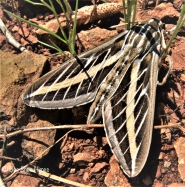
- Mountain Garland, Clarkia unguiculata (hosts Clark's Day Sphinx Moth)
- Chinese Houses, Collinsia heterophylla (hosts Variable Checkerspot)
- Baby Blue-Eyes, Nemophila menziesii (hosts Owlet Moth)
- Five Spot, Nemophila maculate (hosts Alfalfa Looper Moth)
- Farewell to Spring, Clarkia amoena (hosts White Lined Sphinx Moth)
- Punchbowl Godetia, Clarkia bottae (hosts Mariposa Forester)
- Bird’s Eye Gilia, Gilia tricolor (hosts Spotted Sun Straw Moth)
- Grand Linanthus, Linanthus grandifloras (hosts Buckwheat Borer Moth)
The list of moths and butterflies hosted by these plants is just a sample, these plants are a host to many more - a comprehensive list of butterflies each plant hosts, and details about the plants and butterflies, can be found at Calscape.org
*”Host” = key food source for the caterpillars of these particular butterflies, that co-evolved to specialize over thousands of years. Butterflies die out without these plants.
Seed Packet Information: California Pollinator Seed Mix
California Pollinator Seed Mix
We hope you enjoy your seeds from the CNPS SCV Wildflower Ambassadors program. This plant mix provides a variety of sun loving California native annuals and perennials that sustain pollinators over a long season..
Planting Instructions
Fall through winter is the ideal time to start growing California native wildflowers as these have adapted to capitalize on the fall and winter rains (October-February is best) and bloom in spring. They may be planted through April, but after that it is best to wait until at least September to plant them as they do not do well when planted in late spring or summer.
 Choose A Site & Prepare Your Soil
Choose A Site & Prepare Your Soil
- Choose a spacious site in full sun.
- Prepare your soil (or several very large pots), by removing all existing growth and debris. If your soil is clay, break it up with some compost or cactus soil (sold at nurseries).
- Water thoroughly to help seeds settle into the soil. Continue to water a few times a week, unless it rains, so they don’t dry out after germinating. Seeds should sprout in one to three weeks.
- After you plant your seeds, let the area ‘go natural’ by leaving the leaf litter on the ground. While many butterflies go into chrysalis on stems or other hard surfaces like branches, many others go into chrysalis in the debris. If you rake or blow it, you could accidentally kill or throw them away.
Avoid using pesticides anywhere in your garden, it will kill the beneficial insects such as bees, butterflies, moths, and ladybugs that you are trying to attract. Try to ignore bugs, as they are part of the ecosystem (for instance, hummingbirds eat aphids). If you hose the plant or try to remove pests you may dislodge butterfly or ladybug eggs or kill tiny caterpillars. Avoid using herbicides as they also poison the ecosystem you are trying to nurture.
Plants In The California Pollinator Seed Mix
- Yarrow, Achillea millefolium (hosts Northern Scurfy Quaker, Olive Arches, Yarrow Plume Moth, Smeathmann's Aethes Moth)
- Mountain Garland, Clarkia unguiculata (hosts Clark's Day Sphinx Moth)
- Fort Miller Clarkia, Clarkia williamsonii (hosts Clark's Day Sphinx Moth, White-lined Sphinx, Pacific Green Sphinx Moth, Mariposa Forester)
- California Poppy, Eschscholzia californica (useful to pollinators, hosts Acmon Blue, Dotted Blue, Mormon Metalmark, etc.)Lupinus micrantha densiflorus himes crop small
Central Valley Gumplant, Grindelia camporum (hosts Orange Tortrix Moth, Cremastobombycia grindeliella)
- Dense-flowered Lupine, Lupinus microcarpus var. densiflorus (hosts Painted Lady, Acmon Blue, Boisduval's Blue, Silvery BLue, Orange Sulphur)
- Rock Phacelia, Phacelia californica (hosts Oidaematophorus phaceliae, Clepsis fucana, Bilobed Looper Moth, Orange Tortrix Moth)
- Great Valley Phacelia, Phacelia ciliata (hosts Bilobed Looper Moth, Orange Tortrix Moth, Geranium Plumed Moth)
- Bolander's Phacelia, Phacelia bolanderi (hosts Bilobed Looper Moth, Orange Tortrix Moth, Geranium Plumed Moth)
- Serpentine Sunflower, Helianthus bolanderi (hosts Painted Lady, Milbert's Tortoiseshell, California Patch)
The list of moths and butterflies hosted by these plants is just a sample, these plants are a host to many more - a comprehensive list of butterflies each plant hosts, and details about the plants and butterflies, can be found at Calscape.org
*”Host” = key food source for the caterpillars of these particular butterflies, that co-evolved to specialize over thousands of years. Butterflies die out without these plants.
CNPS SCV Wildflower Ambassadors
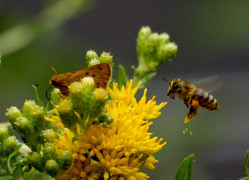 CNPS SCV Wildflower Ambassadors (WFA) promote the use of native plants in gardens to create habitat for our native bees, butterflies, birds and more. They do this by providing information and free native seeds at events and library talks, assisting with tours of local native gardens and other activities. Above all, they have a good time while inspiring people to start their own native gardens and create habitat for our native bees, butterflies, birds and more.
CNPS SCV Wildflower Ambassadors (WFA) promote the use of native plants in gardens to create habitat for our native bees, butterflies, birds and more. They do this by providing information and free native seeds at events and library talks, assisting with tours of local native gardens and other activities. Above all, they have a good time while inspiring people to start their own native gardens and create habitat for our native bees, butterflies, birds and more.
For more information and questions email us at This email address is being protected from spambots. You need JavaScript enabled to view it.. Want to join? Apply here: https://cnps-scv.org/wfa-app.
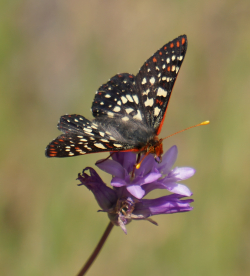 Seed and Garden Information
Seed and Garden Information
Did you receive a free wildflower seed packet from us? Go here for planting instructions and more information about the seeds you received.
Learn more about habitat gardens and native plants on this webpage.
Wildflower Seed Planting
Grow Wildflowers!

 Each seed packet you receive from us contains California native wildflowers in rich hues of gold, orange, pink, purple and blue that will cover two to three square feet or several large pots. You can scatter these seeds in an area planted with native grasses for a meadow effect.
Each seed packet you receive from us contains California native wildflowers in rich hues of gold, orange, pink, purple and blue that will cover two to three square feet or several large pots. You can scatter these seeds in an area planted with native grasses for a meadow effect.
Scattering a packet of native wildflower seeds is a joyful way to restore lost essential habitat while enhancing your gardening experience. We hope you revel in the beauty of the flowers, colorful caterpillars, variety of pollinators, baby birds, and the dance of life in your garden. Together, we can bring back butterflies, bees, and birds. Attend one of our events to receive free seeds. We do not mail seeds.
Planting Instructions
- Choose a site in full sun to partial shade.
- Prepare your soil by removing all existing growth and debris. If your soil is clay, break it up with some compost or cactus mix (sold at nurseries).
- Scatter your seeds over the prepared area. For more even coverage, you can mix your seeds with a little sand before scattering them.
- Water thoroughly to help seeds settle into the soil. Continue to water a few times a week, unless it rains, so they don’t dry out after germinating. Seeds should sprout in one to three weeks.
- After your plants are several inches tall, let the area ‘go natural’ by leaving the leaf litter on the ground. While many butterflies go into chrysalis on stems or other hard surfaces like branches, many others go into chrysalis in the debris. If you rake or blow it, you could accidentally kill or throw them away.
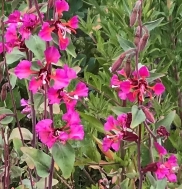 The beauty, color, and scent of flowers bring us joy. However, it's crucial to remember that for bees, butterflies, and birds, flowers serve as a vital source of nourishment for their survival. Plants and flowers provide bees with pollen, butterflies and moths with nectar, and caterpillars with essential food in the form of leaves. Butterflies sip nectar from many flowers but lay their eggs exclusively on specific host plants that will nourish their offspring. The Variable Checkerspot, Silvery Blue, and other butterflies and moths depend on these plants as a food source for their caterpillars. In turn, these caterpillars play a crucial role in the survival of local birds, as 96% of the birds that visit your yard rely on caterpillars to feed their babies. To learn more about this fascinating relationship, consider reading Nature's Best Hope by Doug Tallamy or watching this video. Share this information with your friends and neighbors!
The beauty, color, and scent of flowers bring us joy. However, it's crucial to remember that for bees, butterflies, and birds, flowers serve as a vital source of nourishment for their survival. Plants and flowers provide bees with pollen, butterflies and moths with nectar, and caterpillars with essential food in the form of leaves. Butterflies sip nectar from many flowers but lay their eggs exclusively on specific host plants that will nourish their offspring. The Variable Checkerspot, Silvery Blue, and other butterflies and moths depend on these plants as a food source for their caterpillars. In turn, these caterpillars play a crucial role in the survival of local birds, as 96% of the birds that visit your yard rely on caterpillars to feed their babies. To learn more about this fascinating relationship, consider reading Nature's Best Hope by Doug Tallamy or watching this video. Share this information with your friends and neighbors!
Want more seeds? Check our list of places to buy native seeds.
Contact us with questions at: This email address is being protected from spambots. You need JavaScript enabled to view it.
Resources for Gardeners
The California Native Plant Society (CNPS) is a science-based organization founded in 1965 with a mission to conserve California native plants and their natural habitats, and increase understanding, appreciation, and horticultural use of native plants. The Santa Clara Valley chapter covers Santa Clara County and southern San Mateo County. Check out the great resources on our website and the numerous talks on native plant gardening and native plant science on our YouTube channel. We also have chapter fieldtrips, online plant sales, and other exciting events like our annual Growing Natives Garden tour. The CNPS state website also has excellent resources and information to get you started with native plant science or gardening.
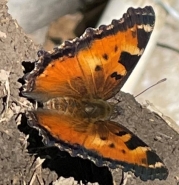 Want to find more California Native plants specific to your area, and the butterflies that use them as host plants? Then check out the wonderful CNPS Calscape website, which includes descriptions and planting information about every California native plant and links to native plant nurseries all over the state. For a user guide to using this amazing resource, watch this talk.
Want to find more California Native plants specific to your area, and the butterflies that use them as host plants? Then check out the wonderful CNPS Calscape website, which includes descriptions and planting information about every California native plant and links to native plant nurseries all over the state. For a user guide to using this amazing resource, watch this talk.
Discover flora and fauna in your region and across the globe, and even post your own observations on the iNaturalist app.
Seek answers to questions:
Why should we grow native plants to save birds and butterflies? Listen to Susan Karasoff here.
How can you restore nature in your garden? Dennis Mudd shares his insights
Where can you find more information about pollinator plants? Juanita Salisbury is an expert who talks about this.
When should you plant, water, prune, or leave things alone? Helen Popper shares a month-by-month guide for California gardeners.
What planting methods and soil will ensure success? Haven Kiers from UC Davis shares some research.
Need Plants? Find nurseries and plant sales using our list.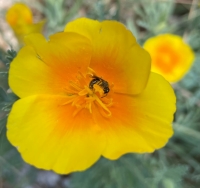
Seeking a few more butterfly resources? The Xerces Society is a great resource as well as the Bay Area Wildlife resource website.
Looking for a list of great books for gardening with native plants and ifor wildlife? Go to our resource page for books.
Need help getting started with a native plant garden? Tips are available in this video
Want to see most of California’s native habitats in one location? Check out the Regional Botanic Garden in Tilden Park.
Here is a list of public gardens with native plants.
Field Trip! Chapter field trips are listed here or on our Meetup page.
Contact us with questions at: This email address is being protected from spambots. You need JavaScript enabled to view it.
2020 CNPS SCV Native Plant Lecture Series
 The CNPS SCV Native Plant Lecture Series was started during the pandemic in 2020. Talks in the series cover a wide range of native plant related topics -- conservation, rare plants, gardening, plant science, tours of botanical hot spots, and more. The talks were live presentations followed by Q&As with the viewing audience.
The CNPS SCV Native Plant Lecture Series was started during the pandemic in 2020. Talks in the series cover a wide range of native plant related topics -- conservation, rare plants, gardening, plant science, tours of botanical hot spots, and more. The talks were live presentations followed by Q&As with the viewing audience.
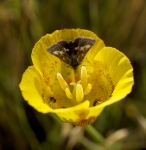 Project 467: Enhancing Native Plant Diversity at Edgewood, Stuart B. Weiss Ph.D.
Project 467: Enhancing Native Plant Diversity at Edgewood, Stuart B. Weiss Ph.D.
Wednesday, December 16, 2020
Watch on YouTube.
Edgewood Natural Preserve near Redwood City is famous for its flower-filled serpentine grasslands. But the 467 acres of Edgewood support great biodiversity in the chaparral, oak woodlands, and grasslands on more fertile soils. The 100+ acres of fertile grasslands are by far the most weed-invaded habitat, and have been the focus of successful control of “macroweeds.” Learn how the Friends of Edgewood and Creekside Science are pursuing the goal of decreasing “microweeds” and increasing native cover and diversity.
A Rapid Assessment Plot (RAP) inventory with over 80 plots documented more than 90 native species in the fertile grasslands, albeit often at low cover. They are investigating treatments to reduce annual weed seedlings just after germination, including hydromechanical pulverization (HMP) -- basically pressurewashing the grassland, and close-mowing with string cutters.
Besides commercially available local seeds, they are using more than 15 species of “boutique” seeds grown at Edgewood Farms and the Native Garden. They are trying to develop a long-term “indigenous” approach to restoration, whereby a beautiful, colorful diversity of native plants is established and can spread naturally given occasional management.
Stu Weiss, Ph.D. (Stanford University) is Chief Scientist of Creekside Science, which provides scientific and conservation expertise to diverse organizations as they cope with the rapidly changing 21st Century environment. He has researched the Bay checkerspot butterfly and serpentine grasslands since 1979, and has authored numerous scientific papers concerning climate/microclimate, population dynamics, nitrogen deposition, and conservation ecology. Creekside Science executes many hands-on restoration projects, including butterfly reintroductions, propagation of endangered plants, and habitat monitoring and management. His research and advocacy were instrumental in the development of the Santa Clara Valley Habitat Plan, and he is Science Advisor for the Bay Area Conservation Lands Network. For more information see www.creeksidescience.com
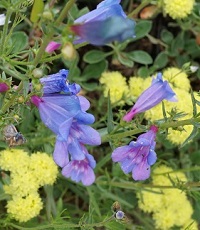 Native Plants for Year-Round Color, a talk by Madeline Morrow
Native Plants for Year-Round Color, a talk by Madeline Morrow
Thursday, December 3, 2020
Watch on Youtube
Learn how to select and group plants with varying bloom times so your garden is never without color. You’ll enjoy it and so will the bees, butterflies, and hummingbirds! See how to choose different plant forms and include beautiful bark, berry, and seed producing species for maximum interest all year long.
Madeline Morrow is a past President of our CNPS Chapter and current board member. A former computer programmer, she now volunteers in her community and works extensively on her native garden. Her garden was featured in Bay Nature magazine in March 2013; and she solved her drainage problem by installing a rain garden.
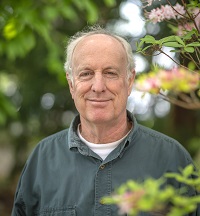 Nature’s Best Hope, A talk by Doug Tallamy
Nature’s Best Hope, A talk by Doug Tallamy
Saturday, November 14, 2020 5:00pm
Watch on Youtube
Recent headlines about global insect declines and three billion fewer birds in North America are a bleak reality check about how ineffective our current land management practices have been at sustaining the plants and animals that sustain us. Such losses are not an option if we wish to continue our current standard of living on Planet Earth. The good news is that none of this is inevitable. Doug Tallamy will discuss simple steps that each of us can and must ̶ take to reverse declining biodiversity and will explain why we, ourselves, are nature’s best hope.
Doug Tallamy is a professor in the Department of Entomology and Wildlife Ecology at the University of Delaware, where he has authored 103 research publications and has taught insect related courses for 40 years. Chief among his research goals is to better understand the many ways insects interact with plants and how such interactions determine the diversity of animal communities. His book Bringing Nature Home: How Native Plants Sustain Wildlife in Our Gardens was published by Timber Press in 2007 and was awarded the 2008 Silver Medal by the Garden Writers' Association. The Living Landscape, co-authored with Rick Darke, was published in 2014. Doug’s new book, Nature’s Best Hope, released by Timber Press in February 2020, is a New York Times Best Seller.
 Wildlife of the Bay Area, a talk by Ameet Zaveri
Wildlife of the Bay Area, a talk by Ameet Zaveri
October 26, 2020 7:30pm
Watch on Youtube
We call the Bay Area our home. How well do we know the wildlife that inhabit this space? Over 400 species of birds, charismatic cats like puma and bobcat, even non-felines like Western Tiger Swallowtail? Can you tell a rattlesnake from a non-venomous snake? Do you know there are *two* whale-watching seasons every year?
Learn about these and other fascinating aspects of wildlife in the Bay Area from naturalist and photographer Ameet Zaveri. An avid naturalist from a young age and a long-time Bay Area resident, Ameet is the founder of the informative website
sfbaywildlife.info. He will share pictures and information about when, where, and how to experience wildlife in the Bay Area, and answer your questions.
 CNPS Vegetation Program: Fine-scale inventory and mapping, a talk by Julie Evens
CNPS Vegetation Program: Fine-scale inventory and mapping, a talk by Julie Evens
Wednesday, October 21, 2020 7:30pm
Watch on Youtube
Julie Evens, the Vegetation Program Director of CNPS, will give an overview of CNPS's Vegetation Program and our broader collaborations on fine-scale vegetation classification and mapping in California to document our state’s incredible vegetation diversity. Julie helps maintain standard methods for surveying, classifying, and mapping vegetation in California and works with agencies, conservancies, and CNPS chapters on vegetation assessment projects, including current projects in the Greater Bay Area, Mojave and Sonoran Deserts, Sierra Nevada foothills, North Coast, Modoc Plateau, among other regions. She is a co-author with John Sawyer and Todd Keeler-Wolf of A Manual of California Vegetation, 2nd edition (http://vegetation.cnps.org), and she is a co-editor with Michael Barbour et al. of California’s Botanical Landscapes: A Pictorial View of the State’s Vegetation. She also helped compile the CNPS Fire Recovery Guide, 1st edition (available for download here: https://www.cnps.org/give/priority-initiatives/fire-recovery). Julie has a M.A. degree from Humboldt State University, and she has two B.A. degrees from the University of California–Santa Cruz.
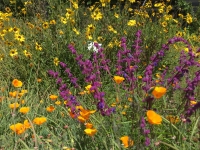 Planting Demo, Nursery Tour and QA session
Planting Demo, Nursery Tour and QA session
Saturday, October 10, 2020 10am
Watch on Youtube
There's a twist on our Going Native Garden Tour session in October -- rather than our usual garden visits, we'll be visiting the CNPS SCV and Grassroots Ecology Nurseries. Our 2020 fall plant sale is going to be online and will start immediately after the session (more information about the CNPS SCV plant sale at http://cnps-scv.org/2020-plant-sale, and Grassroots Ecology's at: https://www.grassrootsecology.org/online-plant-sales). Since you won't be able to come to the nursery to pick your plants out, we're doing our best to bring the nursery to you. This session includes a planting demonstration by Krzysztof Kozminski and tour of the nursery followed by a QA session with knowledgeable native plant gardeners from both nurseries so that you can ask for advice and get answers to questions about specific plants that will be available at their sales.
 CNPS Explorers: A Botanical Quest in Asia & Europe, by Ken and Dee Himes
CNPS Explorers: A Botanical Quest in Asia & Europe, by Ken and Dee Himes
September 24, 2020
Watch on Youtube
Join Ken and Dee Himes as they highlight their 2019 travels from May to November: a journey to Hong Kong, Borneo, Singapore, Penang, India and parts of Europe, on a botanical quest to compare flora and geological features with those of California. The main botanical focus of the trip was in Munsyari, the southern side of the Himalaya in the state of Uttarakhand, India. They will share some of their experiences from a once-in-a-lifetime trek in the Himalaya with three other Chapter members: Arvind Kumar, Ashok Jethanandani, and Joe Cernac. See a surprising geological feature in Hong Kong; orangutans in Borneo; amazing flora in the Himalayas; and other botanical interests in the other countries visited. Of course there will be some interesting insect and bug photos as well.
Ken and Dee Himes have been Chapter members since 1974 (Ken) and 2007 (Dee). Ken is a CNPS Fellow who has held nearly every Chapter position, in addition to leading long-term habitat restoration efforts at Edgewood. Since joining CNPS, Dee has been our Chapter treasurer, field trip chair and board member, a member of the CNPS State Board; and has inspired many with her exceptional photography skills. Ken and Dee were married in 2016, and have continued to celebrate by enjoying interesting plants and habitats wherever they travel.
GNGT: Matadero Garden and Bol Park
September 15, 2020
Watch on Youtube
View two fabulous native plant gardens in Palo Alto with talks and Q&A sessions by their owners and designers. This is a terrific opportunity to get ideas for your own garden and receive advice from experienced gardeners and designers.
Matadero Garden, http://gngt.org/MataderoOaks_GNGT, Melanie Cross & Stephanie Morris
Bol Park Native Garden, http://gngt.org/BolPark_GNGT, Melanie Cross & Claire Elliott
GNGT: Hernandez Backyard & Butterfly House Native Garden
September 2, 2020
Watch on Youtube
Going Native Garden Tour (GNGT - http://gngt.org) - virtual visits to two of the garden on the tour.
Hernandez Backyard in San Jose, http://gngt.org/Hernandez_GNGT
Carrie Levin, Butterfly House Native Garden in Sunnyvale, http://gngt.org/ButterflyHouse_GNGT
 Plant ID for the Curious, a talk by Bruce Homer-Smith
Plant ID for the Curious, a talk by Bruce Homer-Smith
Thursday, August 27, 2020
Watch on Youtube
PlantID.net is a website for people who see a plant in the wild and wonder about it. You enter what you know about your plant (where you are, plant type, color, leaf arrangement, deciduous, has berries, etc.) to get a short illustrated list of possibilities. Then you dive down into photos and captions to learn about your plant.
Bruce is a retired database developer. He loves to learn about plants in the wild because it helps him notice more when he’s out. Since 2012 he’s spent about half of his time programming and adding content to PlantID.net – a labor of love. He works with a large community of plant enthusiasts, adding ID tips and stories to make PlantID.net an extraordinary place to learn about California plants.
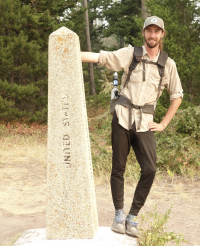 Death Valley ̶ Botanizing High and Low, a talk by Matt Berger
Death Valley ̶ Botanizing High and Low, a talk by Matt Berger
Thursday, July 16, 2020
Watch on Youtube
Matt Berger has hiked from the lowest to the highest points of Death Valley National Park, observing and recording flora throughout its diverse environments. Matt provides an overview of the biogeography and microhabitats of the park, and shares his photos of the limestone endemics and other rare plants. Hear a few of his secrets to finding rare plants in the desert and mountains.
Matt is preceded by the recipient of the CNPS SCV 2019 Graduate Research Scholarship, Lacey Benson from San Jose State University. She describes her research doing a morphometric analysis comparing western sword fern (Polystichum munitum) pinnae size across the coast redwood ecological gradient. Analysis of pinnae morphology will be compared to climate data and will aid in understanding how the longevity of this fern may be affected by climate change.
Matt Berger received his BS in horticulture and and his MS in plant pathology at West Virginia University. Matt is a passionate backpacker having thru hiked the Appalachian Trail, Pacific Crest Trail twice, Continental Divide Trail, Arizona Trail and other long distance trails for a total of over 11,000 miles in the last 8 years. Matt is an accomplished photographer of the plants, fungi and animals that he encounters on his adventures. You can find his photos on Instagram at @sheriff_woody_pct and on YouTube at sheriff_woody_pct.

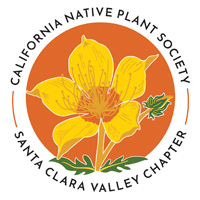


 Choose A Site & Prepare Your Soil
Choose A Site & Prepare Your Soil
 CNPS SCV Wildflower Ambassadors (WFA) promote the use of native plants in gardens to create habitat for our native bees, butterflies, birds and more. They do this by providing information and free native seeds at events and library talks, assisting with tours of local native gardens and other activities. Above all, they have a good time while inspiring people to start their own native gardens and create habitat for our native bees, butterflies, birds and more.
CNPS SCV Wildflower Ambassadors (WFA) promote the use of native plants in gardens to create habitat for our native bees, butterflies, birds and more. They do this by providing information and free native seeds at events and library talks, assisting with tours of local native gardens and other activities. Above all, they have a good time while inspiring people to start their own native gardens and create habitat for our native bees, butterflies, birds and more.  Seed and Garden Information
Seed and Garden Information
 Each seed packet you receive from us contains California native wildflowers in rich hues of gold, orange, pink, purple and blue that will cover two to three square feet or several large pots. You can scatter these seeds in an area planted with native grasses for a meadow effect.
Each seed packet you receive from us contains California native wildflowers in rich hues of gold, orange, pink, purple and blue that will cover two to three square feet or several large pots. You can scatter these seeds in an area planted with native grasses for a meadow effect.  The beauty, color, and scent of flowers bring us joy. However, it's crucial to remember that for bees, butterflies, and birds, flowers serve as a vital source of nourishment for their survival. Plants and flowers provide bees with pollen, butterflies and moths with nectar, and caterpillars with essential food in the form of leaves. Butterflies sip nectar from many flowers but lay their eggs exclusively on specific host plants that will nourish their offspring. The Variable Checkerspot, Silvery Blue, and other butterflies and moths depend on these plants as a food source for their caterpillars. In turn, these caterpillars play a crucial role in the survival of local birds, as 96% of the birds that visit your yard rely on caterpillars to feed their babies. To learn more about this fascinating relationship, consider reading
The beauty, color, and scent of flowers bring us joy. However, it's crucial to remember that for bees, butterflies, and birds, flowers serve as a vital source of nourishment for their survival. Plants and flowers provide bees with pollen, butterflies and moths with nectar, and caterpillars with essential food in the form of leaves. Butterflies sip nectar from many flowers but lay their eggs exclusively on specific host plants that will nourish their offspring. The Variable Checkerspot, Silvery Blue, and other butterflies and moths depend on these plants as a food source for their caterpillars. In turn, these caterpillars play a crucial role in the survival of local birds, as 96% of the birds that visit your yard rely on caterpillars to feed their babies. To learn more about this fascinating relationship, consider reading  Want to find more California Native plants specific to your area, and the butterflies that use them as host plants? Then check out the wonderful CNPS
Want to find more California Native plants specific to your area, and the butterflies that use them as host plants? Then check out the wonderful CNPS 
 The CNPS SCV Native Plant Lecture Series was started during the pandemic in 2020. Talks in the series cover a wide range of native plant related topics -- conservation, rare plants, gardening, plant science, tours of botanical hot spots, and more. The talks were live presentations followed by Q&As with the viewing audience.
The CNPS SCV Native Plant Lecture Series was started during the pandemic in 2020. Talks in the series cover a wide range of native plant related topics -- conservation, rare plants, gardening, plant science, tours of botanical hot spots, and more. The talks were live presentations followed by Q&As with the viewing audience.  Project 467: Enhancing Native Plant Diversity at Edgewood, Stuart B. Weiss Ph.D.
Project 467: Enhancing Native Plant Diversity at Edgewood, Stuart B. Weiss Ph.D. Native Plants for Year-Round Color, a talk by Madeline Morrow
Native Plants for Year-Round Color, a talk by Madeline Morrow Nature’s Best Hope, A talk by Doug Tallamy
Nature’s Best Hope, A talk by Doug Tallamy Wildlife of the Bay Area, a talk by Ameet Zaveri
Wildlife of the Bay Area, a talk by Ameet Zaveri CNPS Vegetation Program: Fine-scale inventory and mapping, a talk by Julie Evens
CNPS Vegetation Program: Fine-scale inventory and mapping, a talk by Julie Evens Planting Demo, Nursery Tour and QA session
Planting Demo, Nursery Tour and QA session CNPS Explorers: A Botanical Quest in Asia & Europe, by Ken and Dee Himes
CNPS Explorers: A Botanical Quest in Asia & Europe, by Ken and Dee Himes Plant ID for the Curious, a talk by Bruce Homer-Smith
Plant ID for the Curious, a talk by Bruce Homer-Smith Death Valley ̶ Botanizing High and Low, a talk by Matt Berger
Death Valley ̶ Botanizing High and Low, a talk by Matt Berger